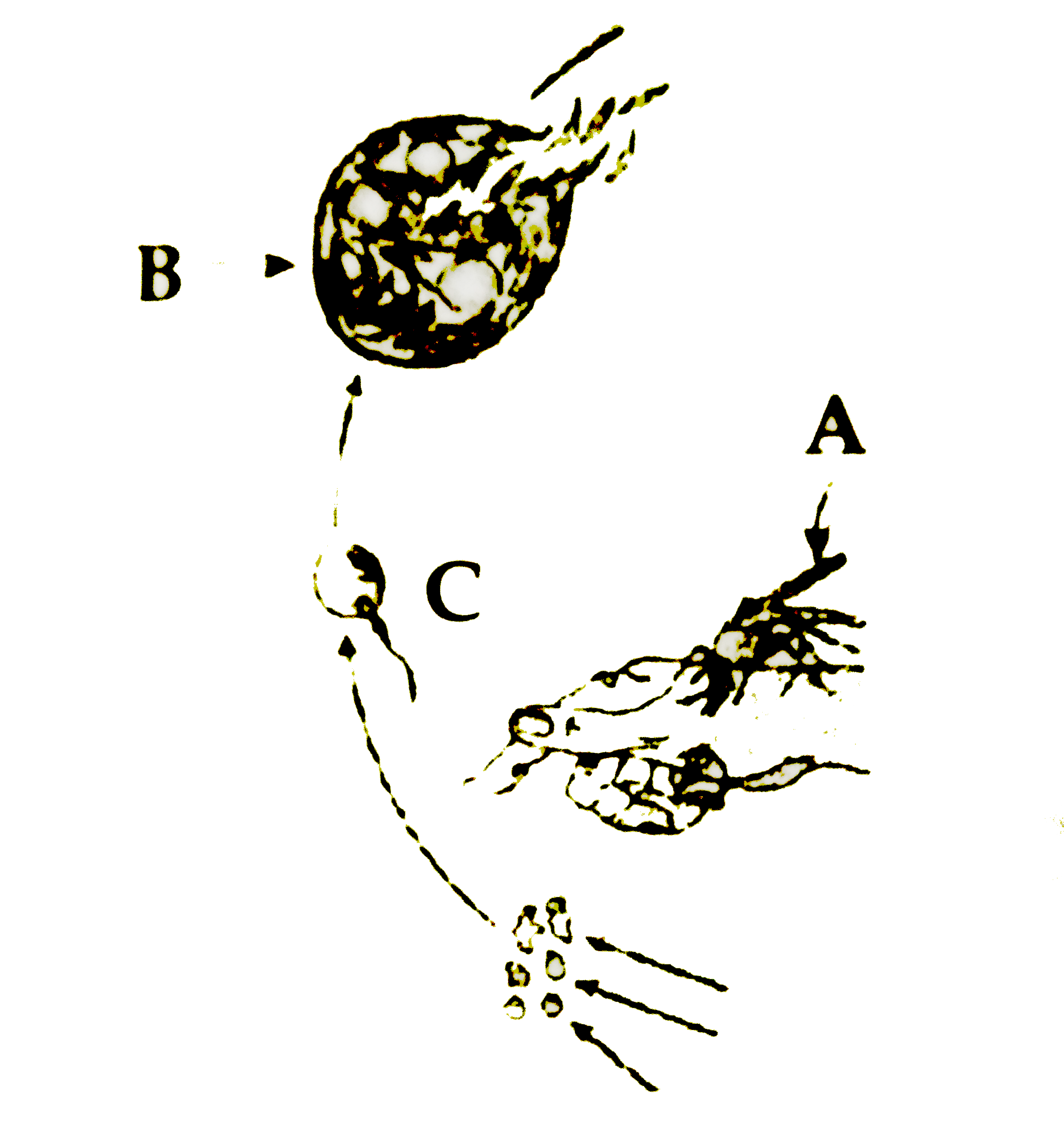Represent schematically the life cycle of a malarial parasite.
Step-by-Step Text Solution for the Life Cycle of a Malarial Parasite
Step 1: Introduction to the Malarial Parasite
- The malarial parasite is known as *Plasmodium* and it has a complex life cycle that involves two hosts: the female Anopheles mosquito and humans.
Step 2: Infection of the Human Host
- The life cycle begins when an infected female Anopheles mosquito bites a human. During this bite, the mosquito injects sporozoites (the infective form of the parasite) into the human's bloodstream.
Step 3: Migration to the Liver
- The sporozoites travel through the bloodstream to the liver, where they invade liver cells (hepatocytes).
Step 4: Asexual Reproduction in the Liver
- Inside the liver cells, the sporozoites reproduce asexually. This process leads to the formation of thousands of merozoites.
Step 5: Release into the Bloodstream
- Once the liver cells are filled with merozoites, they burst, releasing the merozoites back into the bloodstream.
Step 6: Infection of Red Blood Cells
- The merozoites then invade red blood cells (RBCs), where they continue to reproduce asexually. This cycle of invasion and bursting of RBCs leads to the symptoms of malaria, such as fever, chills, and nausea.
Step 7: Formation of Gametocytes
- Some of the merozoites develop into gametocytes, which are the sexual forms of the parasite. These gametocytes can be taken up by another mosquito when it bites an infected human.
Step 8: Transmission to the Mosquito
- When the mosquito bites the infected human, it ingests the gametocytes along with the blood.
Step 9: Fertilization in the Mosquito
- Inside the mosquito's stomach, the gametocytes undergo fertilization, forming zygotes. These zygotes develop into ookinetes, which then transform into oocysts.
Step 10: Development of Sporozoites
- The oocysts grow and divide, producing thousands of sporozoites. These sporozoites migrate to the salivary glands of the mosquito.
Step 11: Cycle Repeats
- When the mosquito bites another human, it injects the sporozoites, thus continuing the life cycle of the malarial parasite.
Summary of the Life Cycle
- The life cycle of the malarial parasite involves two hosts: the human host (where asexual reproduction occurs) and the mosquito host (where sexual reproduction occurs). The cycle includes stages such as sporozoites, merozoites, gametocytes, and zygotes.
---
- The malarial parasite is known as *Plasmodium* and it has a complex life cycle that involves two hosts: the female Anopheles mosquito and humans.
- The life cycle begins when an infected female Anopheles mosquito bites a human. During this bite, the mosquito injects sporozoites (the infective form of the parasite) into the human's bloodstream.
- The sporozoites travel through the bloodstream to the liver, where they invade liver cells (hepatocytes).
- Inside the liver cells, the sporozoites reproduce asexually. This process leads to the formation of thousands of merozoites.
- Once the liver cells are filled with merozoites, they burst, releasing the merozoites back into the bloodstream.
- The merozoites then invade red blood cells (RBCs), where they continue to reproduce asexually. This cycle of invasion and bursting of RBCs leads to the symptoms of malaria, such as fever, chills, and nausea.
- Some of the merozoites develop into gametocytes, which are the sexual forms of the parasite. These gametocytes can be taken up by another mosquito when it bites an infected human.
- When the mosquito bites the infected human, it ingests the gametocytes along with the blood.
- Inside the mosquito's stomach, the gametocytes undergo fertilization, forming zygotes. These zygotes develop into ookinetes, which then transform into oocysts.
- The oocysts grow and divide, producing thousands of sporozoites. These sporozoites migrate to the salivary glands of the mosquito.
- When the mosquito bites another human, it injects the sporozoites, thus continuing the life cycle of the malarial parasite.
- The life cycle of the malarial parasite involves two hosts: the human host (where asexual reproduction occurs) and the mosquito host (where sexual reproduction occurs). The cycle includes stages such as sporozoites, merozoites, gametocytes, and zygotes.
Topper's Solved these Questions
Similar Questions
Malarial parasite is
View SolutionShow with the help of a flow chart only, the life cycle of malarial parasite in humans.
View Solution(a) State what happens in the human body when malarial parasites infected RBCs burst to release the parasites in the blood.
(b) Mention the specific sites in the host body where production of
(i) sporozoites and (ii) gametocytes take place in the life cycle of the malarial parasites.View SolutionName the host and the site where the following occur in the life cycle of a malarial parasite :
(a) Formation of gametocytes.
(b) Fusion of gametocytes.View SolutionName the host and the site where the following occur in the life cycle of a malarial parasite.
Formation of gametocytesView SolutionName the host and the site where the following occur in the life cycle of a malarial parasite.
Fusion of gametocytes.View SolutionStudy a part of the life cycle of malarial parasite given below. Answer the questions that follows: (a) Mention the roles of 'A' in the life cycle of the malarial parasite.
(b) Name the event 'C' and the organ where this event occurs .
(c) Identify the organ 'B' and name the cells being released from it.
 View Solution
View SolutionStudy a part of the life cycle of malarial parasite given below. Answer the questions that follows: (a) Mention the roles of 'A' in the life cycle of the malarial parasite.
(b) Name the event 'C' and the organ where this event occurs .
(c) Identify the organ 'B' and name the cells being released from it.
 View Solution
View SolutionWhich of the following events are not associated with the phase /cycle of malarial parasite in man ?
View SolutionThe life cycle of cord moss is
View Solution

